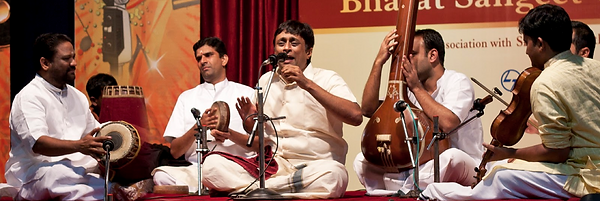
Orchestra components
A key component of Indian music is the broad variety of instruments that are utilised. Apart from vocals, there are string instruments, such as the Violin (this is the most extensively used for both Hindustani and Carnatic concerts), pluck instruments such as Sitar (Hindustani), Sarod (Hindustani), Veena (Carnatic) and Mandolin (Western, but it can be adapted into Indian music: see Mandolin U. Srinivas for an example), wind instruments such as the Flute (the Hindustani form is the "Bansuri" whereas the Carnatic form is the "Venu") and Nadaswaram (Carnatic), and percussion such as Mridangam (Carnatic), Tabla (Hindustani) among others.
The following image shows what a traditional Indian musical concert usually looks like:

The vocalist is usually seated in the centre with the percussion (Mridangam player, far left), and the violinist (far right) seated at the ends of the stage. There may be additional percussionists (the second person from the left, who is playing what is known as the Khanjira) as well. The third person from the left (sitting right next to the violinist), is playing a special instrument known as the Tambura, which sets the base pitch for the concert and acts as a drone (more on this in the subsequent posts!). A vocalist is not essential for the concerts, as flute-dominated or violin-dominated concerts, for instance, can also exist (but a percussion-dominated concert is relatively rare).